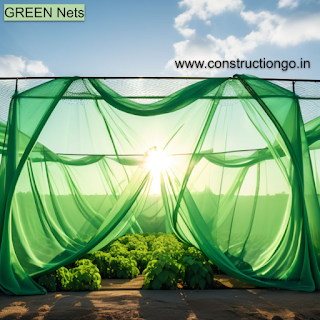Summer is Coming and to protect heavy sun rise Green nets are the best option.
Title: Harnessing the Power of Green Nets for Sun Protection: Types, Uses, and Installation
Introduction:
In the quest for sustainable and eco-friendly solutions, green nets have emerged as a versatile tool for sun protection. These nets, woven from high-quality materials, not only shield against the harsh rays of the sun but also contribute to environmental conservation. In this article, we will explore the various types of green nets, their quality, utility, and installation procedures, as well as their advantages and disadvantages.
Types of Green Nets and Quality:
Green nets come in a variety of types, each designed to cater to specific needs and environments. Shade nets, windbreak nets, and anti-hail nets are some common types. The quality of a green net is largely determined by its material and weaving technique. High-density polyethylene (HDPE) is a popular material for its durability and resistance to UV radiation. The weaving pattern influences factors like shade percentage and air circulation, contributing to the net's overall effectiveness. Utility and Applications:
Green nets find applications in diverse settings, proving their usefulness in agriculture, horticulture, and even domestic spaces. In agriculture, shade nets protect crops from excessive sunlight, preventing sunburn and heat stress. Windbreak nets shield plants from strong winds, reducing water evaporation and preventing soil erosion. Anti-hail nets provide a protective barrier against hailstorms, preserving the quality of fruits.
How to Fix Green Nets:
Installing green nets requires careful consideration of the specific purpose and environmental conditions. Begin by measuring the area to be covered and selecting the appropriate shade percentage. Secure the netting using sturdy support structures such as poles or frames. Regular maintenance, including checking for tears or damage, ensures the longevity of the green net.
Disadvantages of Green Nets:
While green nets offer numerous benefits, they do come with some disadvantages. Over time, exposure to the elements can cause wear and tear, reducing the net's efficacy. Improper installation or inadequate maintenance may lead to sagging or tearing. Additionally, the initial cost of high-quality green nets can be higher than traditional alternatives.
Benefits of Green Nets:
The advantages of green nets far outweigh their drawbacks. By regulating sunlight, these nets promote optimal conditions for plant growth, resulting in increased yields and improved quality of crops. The reduction in water evaporation and protection from extreme weather events contribute to sustainable farming practices. Moreover, the use of green nets aligns with environmental conservation efforts, as they minimize the need for harmful pesticides and chemicals.
Places Where Green Nets are Used:
Green nets find applications in a variety of settings, including:
1. Agriculture: Protecting crops from excessive sunlight, wind, and hail.
2. Horticulture: Providing shade and protection for nurseries and gardens.
3. Residential Spaces: Creating shaded areas in gardens, patios, and outdoor spaces.
4. Construction Sites: Shielding workers from the sun and creating a comfortable working environment.
5. Recreational Areas: Establishing shaded zones in parks, playgrounds, and sports facilities.
Green nets offer a sustainable solution for sun protection, proving their effectiveness in various sectors. With careful selection, proper installation, and regular maintenance, these nets can contribute significantly to enhanced agricultural productivity, reduced environmental impact, and improved living conditions in both rural and urban settings. As the world continues to prioritize eco-friendly alternatives, green nets stand out as a practical and environmentally conscious choice for sun protection.
When it comes to Green nets or shade nets, the term "GSM" typically refers to the Grams per Square Meter, which is a measure of the weight or density of the material. The GSM of a shade net is an important factor that determines its strength, durability, and effectiveness in providing shade. Here are some common GSM ranges for shade nets:
1. 50-90 GSM: Light-duty shade nets, suitable for providing partial shade and protection against mild sunlight. They are commonly used in nurseries and for shading young plants.
2. 90-120 GSM: Medium-duty shade nets, offering moderate shade for crops and plants. These nets are versatile and find applications in agriculture, horticulture, and residential areas.
3. 120-200 GSM: Heavy-duty shade nets, providing substantial shade and protection against intense sunlight. These nets are often used in commercial agriculture, construction sites, and areas where robust sun protection is required.
The choice of GSM depends on factors such as the type of crops or plants being protected, the local climate, and the specific requirements of the application. It's essential to select the appropriate GSM to ensure that the shade net meets the desired level of sun protection while also being durable and long-lasting.
Additionally, the GSM can also vary based on the weaving pattern and material of the shade net. High-quality shade nets are often made from materials like high-density polyethylene (HDPE), which adds to their durability and UV resistance.
When purchasing shade nets, it's advisable to consult with suppliers or manufacturers who can provide guidance on the most suitable GSM for your specific needs. The goal is to strike a balance between providing adequate shade and maintaining proper air circulation for the well-being of the plants or the intended purpose of the shade net.
By:- Rehan Qamar
 Reviewed by Rehan Qamar
on
February 22, 2024
Rating:
Reviewed by Rehan Qamar
on
February 22, 2024
Rating:








No comments:
Please click on follower button